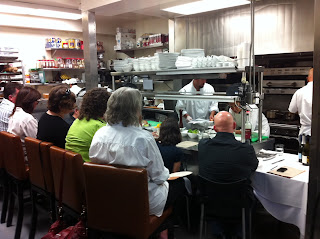
I think there have been volumes written already on the danger of continuing to use cork as a closure for wine and all of the many reasons why we, as consumers, will not allow a clean changeover to any other means of sealing wine bottles. I certainly don't want to re-hash old information because I assume, if you are reading this blog about wine, that you already know the basics about it. Far be it from me to bore you with things you have already heard a hundred times before.
In light of my step-father's loss of a magnum of Harlan Estate Cabernet to TCA, I promised him I'd create a blog entry so the $1000 bottle we had to pour down the drain was not a complete loss. I figured it was the least I could do. And what better time to hit this topic that when it strikes in the most costly of forms!
In recent weeks, I have been cursing the day that I became familiar with TCA and my ability to notice it in wine. I've been coming across more and more faulty wines. With the ability to spot TCA, you wind up dumping a lot of wines down the drain. I hazard to think of how many faulty bottles I may have consumed prior to the moment when that unwelcomed musty smell became all too familiar. In retrospect, I think that Texas Chardonnay that I bought at the Dollar Store out of morbid curiousity was tragically corked. I remember pouring that one down the drain, thank God!
It amazes me how many people will open an expensive bottle of wine, notice that something is off about it (most usually TCA), and force themselves to drink it anyway. Of course it hurts to pour any amount of money down the drain! But what's in the bottle is also not the product you purchased, nor the product that the winery and winemaker wanted you to enjoy. It would be like buying a bag of Cool Ranch Doritos and opening it to find flavorless rice cakes. Gross! You probably would force those down if you were expecting Doritos. Why would you drink a faulty wine?
On a personal level, it makes for a very uncomfortable situation when dining or drinking with friends. As the professional sommelier, I generally have to be the person to announce to someone that their wine is toast and needs to be dumped. For example, when dining at Cuistot in the desert this past week with my folks, I discovered the '95 Dom Perignon he brought was infected with TCA. I thought there was a good chance Dave might catch this one, since we'd just had it at Spago a week before, but it slipped by him. Thankfully, I'd ordered a martini already and no one noticed that I wasn't drinking the bubbles. Kara chastised me for not saying anything, but it's very difficult to be the person to announce that your expensive bottle of wine can't be drunk.
In my experience, some wineries will take ownership of those faults, despite it not really being any wrong-doing of their own. I'm certainly not going to ask Harlan to replace a maggie because I don't think there's a snowball's chance in Vegas that they would, but smaller producers who are making a name for themselves or big producers who don't want to lose your business might. Sometimes, even the retailer who sold you the wine will take the wine back and deal with the winery or ditributor themselves so you experience a better level of service from their end. It's always worth a try, I think. Certainly at the restaurant level, we are obliged to keep you from drinking a faulty product that we are selling.
I'm becoming more accepting every month of any new form of closure. Watching all of this hard-earned money go to waste is becoming more sickening. Yes, there are concerns about longevity, oxidation, age-ability, and more. But what about the fact that all of this wine is being destroyed? And even more frightening, what if that had been someone's very first bottle of Harlan, thereby forming their first and probably only impression about that winery with a disgustingly corked bottle? The damage being done to wineries is almost more frightening.
I will get off of my soap box now. Every so often, I think most sommeliers have a build up that needs a release. Blowing off of steam, if you will. My advice to you as a consumer is to make a concerted effort to learn the smell of TCA in wine, if you don't recognize it already. Know if what you have in your bag is actually Doritos or if someone duped you with rice cakes. It's your moral obligation to yourself and the wineries you support with your precious dollars.





